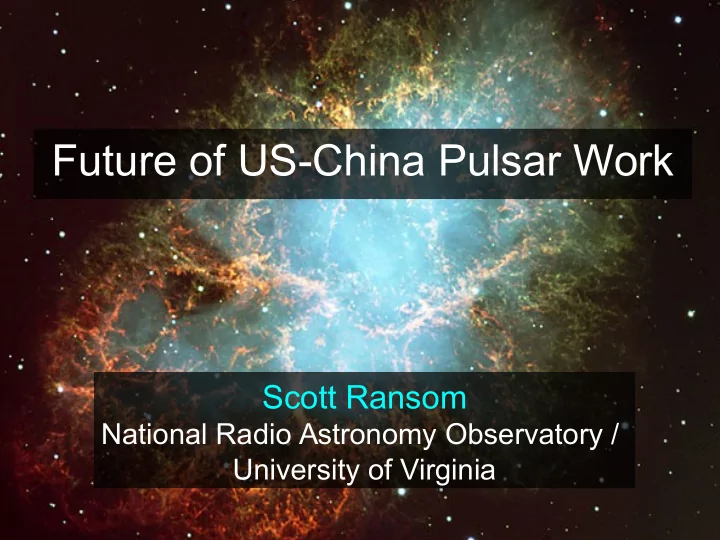

Future of US-China Pulsar Work Scott Ransom National Radio Astronomy Observatory / University of Virginia
What are pulsar radio properties? • Continuum point sources • Quite linearly polarized • Steep radio spectra (index ~ -2) so 0.3-3 GHz obs • Dispersion (~ ν -2 ) scattering (~ ν -4 ) push to higher freqs • Highly time variable • No confusion or beam dilution • Very faint average flux density ~mJy • RFI is a big problem, affects slow pulsars much more than MSPs
What are pulsar radio properties? • Continuum point sources 1 mJy PSR @ 1 GHz: • Quite linearly polarized 0.25-0.33 mJy @ 2 GHz • Steep radio spectra (index 0.06-0.11 mJy @ 4 GHz ~ -2) so 0.3-3 GHz obs 0.01-0.03 mJy @ 8 GHz • Dispersion (~ ν -2 ) scattering (~ ν -4 ) push to higher freqs • Highly time variable • No confusion or beam dilution • Very faint average flux density ~mJy • RFI is a big problem, affects slow pulsars much more than MSPs
What are pulsar radio properties? • Continuum point sources 1 mJy PSR @ 1 GHz: • Quite linearly polarized 0.25-0.33 mJy @ 2 GHz • Steep radio spectra (index 0.06-0.11 mJy @ 4 GHz ~ -2) so 0.3-3 GHz obs 0.01-0.03 mJy @ 8 GHz • Dispersion (~ ν -2 ) scattering (~ ν -4 ) push to higher freqs • Highly time variable • No confusion or beam dilution We are completely sensitivity • Very faint average flux limited now, unlike in recent past. density ~mJy • RFI is a big problem, FAST will be excellent affects slow pulsars much more than MSPs
Pulsar Population of the Galaxy ~2300 pulsars known, but the Galaxy has ~30000 (and ~10000 MSPs) Non-recycled Only 2-3% of known Normal pulsars are “interesting” Recycled: Pulsars for basic/astro physics Binaries Isolated individually Double-NSs In Galaxy, we know: ~160 binary MSPs ~40 isolated MSPs Millisecond Pulsars ~40 binary part-recyc (MSPs) ~20 isolated part-recyc Definitions : “Recycling” Part-recycled: P > 20 ms, B < 3x10 10 G MSP : P < 20 ms, B < 10 9 G
Ongoing All-Sky Pulsar Surveys ● All major radio Northern scopes: – Arecibo: P-ALFA (7x1.4GHz) and AO-Drift (1x327MHz) – GBT: GBNCC (1x350MHz) – LOFAR: several – Effelsberg: HTRU (7x1.4 GHz) ● Lots of data (~50-200 MB/s) ● Millions of candidates – Due to big param space and RFI ● 200-300 PSRs in next few years ● Timing (~1yr) of every pulsar is a crucial part of the survey – identifies the interesting ones!
New Millisecond Pulsars Numbers have: more than quadrupled in last 10 yrs doubled in last ~4 years Year Crucial for Pulsar Timing Array experiments for gravitational waves
Recent exotic systems... • Double pulsar J0737-3039 (Lyne et al., Science , 2004) • Radio magnetar XTE J1810-197 (Camilo et al., Nature , 2006) • P-dot changing PSR B1931+24 (Kramer et al., Science , 2006) • Rotating Radio Transients (McLaughlin et al., Nature , 2006) • Eccentric MSP J1903+0327 (Champion et al., Science , 2008) • “Missing Link” MSP J1023+0038 (Archibald et al., Science , 2009) • 2-Msun MSP J1614-2230 (Demorest et al., Nature , 2010) • “Diamond Planet” J1719-1438 (Bailes et al., Science , 2012) • Massive NS J0348+0432 (Antoniadis et al., Science , 2013) • MSP-LMXB switching M28I (Papitto et al., Nature , 2013) • MSP in triple system J0337+1715 (Ransom et al., Nature , 2014) • Future? : MSP-MSP, PSR-BH, sub-MSP, ultra-massive, ….
Chinese Telescopes and Pulsars FAST will be fantastic (sensitivity + sky coverage) • Surveys should find 1000-2000 new pulsars • But: if 10-min slew times, how do you time and confirm? • Will be very difficult with FAST, but need its sensitivity! QTT, Arecibo, GBT – but will take a lot of telescope time • For confirmation, maybe do full sky twice with driftscans • QTT: will be great (sensitivity + sky coverage) • Excellent general-purpose pulsar telescope (like GBT) • SHAO 65-m: probably niche uses for pulsars • RFI will dramatically limit use of L-band and S-band • C-band population studies of spectral indices •
Timing: want all the useful bandwidth 0.5 – 3 GHz receiver/backend • ~40% total SNR improvement • ~60% timing improvement from SNR and DM alone • much better systematics • ~2.5 GHz bandwidth sampled in one chunk • ~GUPPI x3 (realtime dedispersion with GPUs – DIBAS modes in VEGAS)
Scaled Caltech quad-ridge feed Ahmed Akigray and • Sandy Weinreb Looking for funding as part • of NANOGrav's NSF MSIP proposal for GBT Suggest design can be (easily) tweaked to achieve: • 3% spillover noise at 1.4GHz and zenith • 60% aperture efficiency over full band (~0.5-3 GHz) • Tsys ~ 29K (5K sky + 9K spill + 4K coax jct + 7K dewar jct + 3K LNA) • Total size is ~1m long and ~1m in diameter • Achieving a competitive Aeff / Tsys is the key... and will be tricky!
Observations will be more efficient and have much better systematics (ISM)
Summary There was a pulsar renaissance in the last • decade because of instrumentation There will be another in the next decade from • new telescopes (esp FAST, MeerKAT, SKA-1) Current telescopes (esp GBT and Arecibo) will • crucial for follow-up observations of new PSRs A huge amount of exciting new science to come: • Gravitational waves, neutron star masses, exotic • systems, plasma and nuclear physics, GR tests, ...
Recommend
More recommend